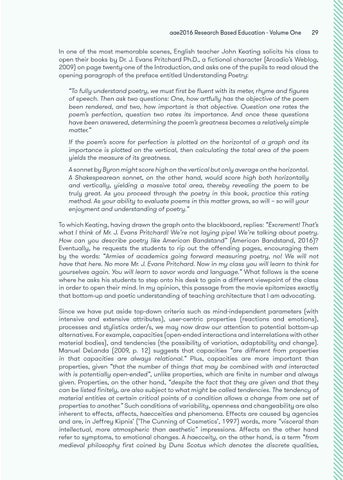aae2016 Research Based Education - Volume One
29
In one of the most memorable scenes, English teacher John Keating solicits his class to open their books by Dr. J. Evans Pritchard Ph.D., a fictional character (Arcadio’s Weblog, 2009) on page twenty-one of the Introduction, and asks one of the pupils to read aloud the opening paragraph of the preface entitled Understanding Poetry: “To fully understand poetry, we must first be fluent with its meter, rhyme and figures of speech. Then ask two questions: One, how artfully has the objective of the poem been rendered, and two, how important is that objective. Question one rates the poem’s perfection, question two rates its importance. And once these questions have been answered, determining the poem’s greatness becomes a relatively simple matter.” If the poem’s score for perfection is plotted on the horizontal of a graph and its importance is plotted on the vertical, then calculating the total area of the poem yields the measure of its greatness. A sonnet by Byron might score high on the vertical but only average on the horizontal. A Shakespearean sonnet, on the other hand, would score high both horizontally and vertically, yielding a massive total area, thereby revealing the poem to be truly great. As you proceed through the poetry in this book, practice this rating method. As your ability to evaluate poems in this matter grows, so will – so will your enjoyment and understanding of poetry.” To which Keating, having drawn the graph onto the blackboard, replies: “Excrement! That’s what I think of Mr. J. Evans Pritchard! We’re not laying pipe! We’re talking about poetry. How can you describe poetry like American Bandstand” (American Bandstand, 2016)? Eventually, he requests the students to rip out the offending pages, encouraging them by the words: “Armies of academics going forward measuring poetry, no! We will not have that here. No more Mr. J. Evans Pritchard. Now in my class you will learn to think for yourselves again. You will learn to savor words and language.” What follows is the scene where he asks his students to step onto his desk to gain a different viewpoint of the class in order to open their mind. In my opinion, this passage from the movie epitomizes exactly that bottom-up and poetic understanding of teaching architecture that I am advocating. Since we have put aside top-down criteria such as mind-independent parameters (with intensive and extensive attributes), user-centric properties (reactions and emotions), processes and stylistics order/s, we may now draw our attention to potential bottom-up alternatives. For example, capacities (open-ended interactions and interrelations with other material bodies), and tendencies (the possibility of variation, adaptability and change). Manuel DeLanda (2009, p. 12) suggests that capacities “are different from properties in that capacities are always relational.” Plus, capacities are more important than properties, given “that the number of things that may be combined with and interacted with is potentially open-ended”, unlike properties, which are finite in number and always given. Properties, on the other hand, “despite the fact that they are given and that they can be listed finitely, are also subject to what might be called tendencies. The tendency of material entities at certain critical points of a condition allows a change from one set of properties to another.” Such conditions of variability, openness and changeability are also inherent to effects, affects, haecceities and phenomena. Effects are caused by agencies and are, in Jeffrey Kipnis’ (‘The Cunning of Cosmetics’, 1997) words, more “visceral than intellectual, more atmospheric than aesthetic” impressions. Affects on the other hand refer to symptoms, to emotional changes. A haecceity, on the other hand, is a term “from medieval philosophy first coined by Duns Scotus which denotes the discrete qualities,
